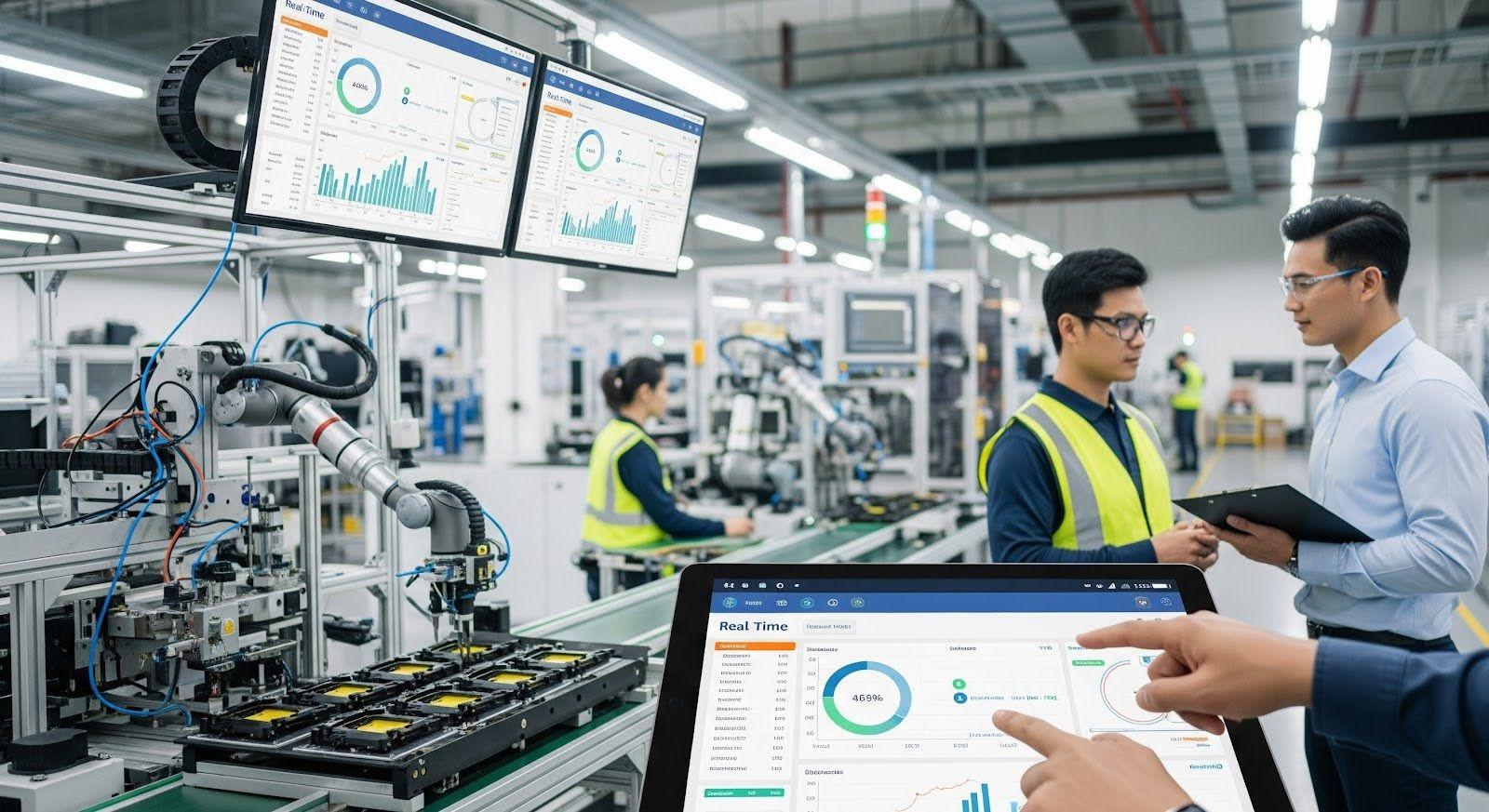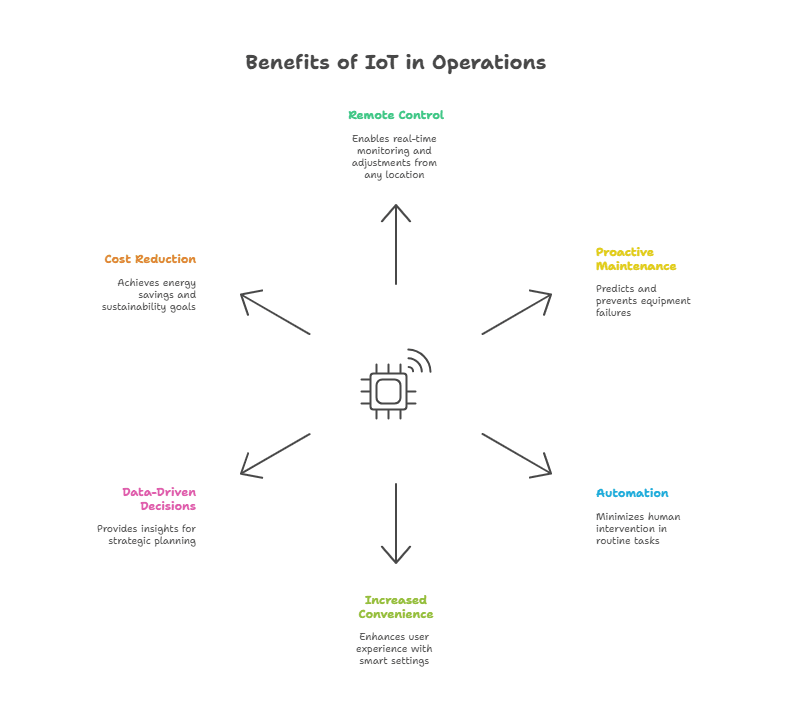How IoT Development Can Help Improve Operations And Enhance Efficiency

Key Takeaways:
- IoT redefines operations by connecting smart devices, enabling automation, real-time monitoring, and remote control.
- Predictive analytics powered by IoT reduces downtime, prevents costly repairs, and improves asset longevity.
- Automation enhances efficiency, minimising errors, streamlining workflows, and lowering operational costs.
- IoT improves user comfort and security through intelligent environmental adjustments and instant threat detection.
- Custom IoT development services provide tailored, scalable solutions that align with industry-specific needs and long-term strategies.
- Wide applications across industries such as manufacturing, healthcare, logistics, retail, and facility management drive innovation and competitiveness.
Introduction
IoT (The Internet of Things) has fundamentally reimagined how we conduct business operations, driving innovation and growth in ways previously unimaginable. It has transformed traditional industries into smart, data-driven ecosystems, resulting in increased operational efficiencies and reduced costs.
IoT development is the process of developing and integrating smart devices that connect to a network—usually the internet— to orchestrate interaction with people and other systems. In practice, this connectivity enables remote control, automation, and real-time data collection from physical environments, enabling smarter decision-making.
Strategically, IoT offers immense value to modern business operations. For instance, it enhances efficiency through optimised resource management and streamlined workflows. It also supports proactive maintenance by predicting equipment failures.
Additionally, IoT improves comfort by enabling the automation of routine tasks and personalised control, transforming how people manage their environments.
What is IoT Development?
IoT development services and IoT app development are specialised services that revolve around the methodical processes of creating custom software to connect devices to a network and bridge physical sensors, user apps, gateways, and cloud infrastructure.
Typically, the end result of these services is an ecosystem where devices interface whilst allowing real-time data collection and intelligent operations via dedicated apps.
Overall, custom IoT app development and integration enable businesses to monitor device status, automate responses, and manage devices remotely across various environments. By connecting devices to a network via tailored IoT software solutions, companies can augment decision-making and better optimise operations to align with specific use cases.

How Does IoT Work?
IoT operates by linking physical devices (that possess sensors and actuators) to a network to collect and exchange data. In practice, these ‘smart’ physical devices send the gathered information to an IoT gateway. This gateway serves as a bridge to relay data securely to cloud servers for further processing.
The connectivity between smart devices and the network is typically established using various protocols like Wi-Fi, Bluetooth, cellular networks, or specialised IoT standards. Once data reaches the cloud, to extract valuable insights and identify trends, the data is aggregated and analysed using machine learning, AI or custom algorithms.
IoT devices can be programmed to perform automated tasks, including changing settings or issuing warnings, without the need for human intervention. The feedback loop from device connectivity to informed action can also be completed by users through web or mobile apps.
Core Elements of IoT
IoT is underpinned by four core elements, which collectively enable data collection, automation, and remote control, namely:
- Smart Devices: These are specialised ‘intelligent’ devices equipped with sensors that continuously collect data from physical environments. They collect data like temperature, motion, or humidity, which is then relayed via Wi-Fi, Bluetooth, or cellular networks.
- Connectivity: Device connectivity is fundamental in interfacing the physical world with digital systems, allowing the IoT ecosystem to operate cohesively.
- Data Collection and Processing: These elements revolve around the data processing layer, where data is aggregated and analysed in the cloud to extract actionable insights.
- User interfaces: These are the mediums (dashboards or apps)*/ through which humans can orchestrate IoT automation tasks, thus enabling remote control and management of IoT devices.
Key Benefits of IoT in Operations

IoT is continually evolving with its influence expanding across new frontiers to drive innovation and offer several benefits, such as:
Enabling Remote Control and Monitoring
(IoT) enables the remote monitoring of equipment, surroundings, or workflows in real time from any location by connecting sensor-equipped devices to a network. Beyond empowering equipment operators to track performance and detect potential issues early, it also enables them to make immediate changes remotely.
This capability not only enhances operational agility but also boosts convenience when managing distributed assets across multiple sites. More importantly, it adds a layer of security by enabling rapid detection of threats to safeguard sensitive operations.
Proactive Maintenance Through Predictive Analytics
IoT sensors are essential to proactive maintenance. They continuously assess the state of equipment or infrastructure and identify irregularities that predate problems.
By using IoT as part of their predictive strategies, businesses may foresee issues to take action before they escalate. This, in turn, greatly increases equipment uptime and prevents expensive unplanned repairs. It also facilitates scheduled maintenance, which optimises resource allocation, lowers labour costs, and increases asset longevity.
Automation and Operational Efficiency
IoT enables devices and systems, such as machinery, lighting, HVAC, and workflows, to operate with minimal human intervention. Its ability to automate routine tasks appreciably reduces waste, errors, and inefficiencies. It, therefore, augments operational precision and speed.
Furthermore, it increases convenience for users by allowing systems to self-adjust based on real-time data, lowering the total cost of operations.
Increased Convenience and Comfort (and Security)
IoT improves user experience by establishing intelligent settings that automatically adjust to personal requirements, tastes, or environmental changes. For example, HVAC systems that maximise comfort while preserving energy, or smart lighting that modifies brightness according to occupancy. By identifying anomalous activity and sending out immediate notifications, IoT also improves security in sensitive or remote operations. Thereby, improving both digital and physical safety in real time.
Data-Driven Decision-Making
IoT’s data collection capabilities empower managers with real-time insights into operational performance, resource utilisation, and possible inefficiencies. These insights can subsequently be leveraged to formulate evidence-based strategies, innovate through intelligent automation, and improve workflows. Thereby, giving companies a competitive advantage.
Cost Reduction and Sustainability
IoT-driven automation supports energy cost savings and sustainability objectives with its ability to orchestrate smart lighting and effective resource management. This, in turn, enables businesses to minimise their environmental impact and reduce operating expenses.
Application Areas of IoT in Operations
IoT has several disparate application use cases in business operations. Let’s take a look at some, shall we?
Smart Facility & Equipment Management
IoT plays an indispensable role in smart facility and equipment management. Principally, it enables intelligent control and monitoring of systems like HVAC, lighting, and asset tracking.
For context, IoT sensors can monitor environmental conditions and equipment performance in real time. They can also orchestrate automated adjustments that optimise energy utilisation and help locate equipment to reduce losses, making facility management more efficient and cost-friendly.
Read this case study on Coffee Bot IoT Development by Techies
Industrial or Manufacturing Operations
In industrial and manufacturing settings, IoT is often deployed for machine health monitoring, energy usage tracking, and automated alert systems.
For example, IoT sensors can collect machinery collect data on operational parameters to detect signs of wear or unusual behaviour. Thereby, facilitating predictive maintenance, minimising downtime, and maximising productivity.
Logistics & Fleet Operations
IoT provides critical advantages for fleet operations and logistics, including route optimisation, predictive maintenance, and real-time vehicle tracking. For instance, IoT-driven real-time tracking provides visibility into vehicle location and status. This, in turn, enables dynamic route adjustments for faster, more reliable deliveries.
Furthermore, IoT-derived sensor data can empower predictive maintenance capabilities to foresee and prevent vehicle breakdowns. Thereby, appreciably reducing downtime and repair costs.
Techies have demonstrated expertise in developing operational efficiency solutions like logistics-related dashboards and apps. For example, online and mobile apps for logistics firms that integrate multiple suppliers via cloud platforms.
Healthcare and Remote Patient Monitoring
Healthcare IoT-enabled devices continuously monitor patient vitals, enabling remote monitoring and prompt intervention. In practice, these devices allow medical professionals access to real-time data, which enhances patient outcomes and overall care efficiency.
IoT-enabled remote control of medical equipment also helps manage medication delivery and emergency alerts without requiring patients to visit hospitals frequently.
Retail and Customer Experience
IoT is revolutionising the retail customer experience through inventory tracking, smart shelves, and customised in-store interactions. For example, automated stock level monitoring by smart shelves can help prevent shortages by initiating restocking procedures.
Furthermore, using IoT for inventory tracking increases stock-keeping accuracy and appreciably reduces theft incidents. Additionally, IoT orchestrates more individualised shopping experiences by adjusting in-store displays and promotions in real-time according to customer preferences and actions.
Why Custom IoT Development Matters?
Custom IoT development services provide tailored solutions that precisely meet the unique needs and evolving demands of businesses. In stark contrast, off-the-shelf tools offer generic features designed for broader use cases but aren’t relevant to unique customer nuances.
However, custom IoT development addresses clients’ specific operational processes, compliance requirements, and integration challenges with existing systems. Additionally, it enables enterprises to flexibly expand and adapt their IoT ecosystem as market demands and technology trends evolve. Thereby, future-proofing their investments and aligning with long-term strategic goals in a manner that off-the-shelf alternatives cannot.
Moreover, custom IoT development combines software engineering with UI/UX design, APIs, cloud services, and post-deployment support. Beyond IoT device interoperability, this holistic integration approach gives users intuitive control and seamless access to data and insights.
How to Choose the Right IoT App Development Company
When assessing a prospective IoT development services company to ensure the best fit for your project, consider:
- Experience and expertise: Providers with experience relevant to your industry will better understand the complexities and specific requirements of your domain.
- Technical capabilities: Look out for full-stack development skills, proficiency with IoT protocols, and the ability to support scalability and system optimisation.
- Effective communication and collaboration: They should ensure transparency, timely updates, agile responsiveness to changes, and solid post-development support.
Techies provides state-of-the-art IoT development services through its team of competent professionals who excel in delivering comprehensive full-stack solutions.
With capabilities spanning mobile app development, web app development, and cloud services, we ensure seamless connectivity across disparate devices and platforms. Combined with a client-centric approach, our scalable, secure, and customised IoT solutions meet diverse business needs and drive digital transformation efficiently.
Conclusion
IoT development disrupted many industries, driving innovation in ways previously unimaginable. It has transformed traditional sectors such as manufacturing, healthcare, retail, and logistics into smart, data-driven ecosystems.
For example, manufacturing floors have become automated and predictive. In the same breadth, healthcare services have embraced real-time patient monitoring and diagnostics.
Relatedly, retail outfits now offer personalised shopping experiences that reduce operational costs and enhance user convenience. Beyond industrial impact, its continuous data collection and integration capabilities enable businesses to adapt dynamically to changing environments.
To enhance overall operational agility, improve resource management, and stay competitive in fast-evolving markets, it's imperative to choose the right IoT app development or custom IoT development services partner. Customised development ensures relevance, scalability, and seamless integration with existing systems.
Techies’ full-stack mobile and web app development services and a client-centric agile approach can accelerate innovation and maximise the value of IoT investments. So, reach out for a consultation regarding future-ready IoT solutions.
About Author
Kok Weng
Kok Weng Kong is a tech enthusiast and problem-solving expert with a passion for technology and innovation. As the Founder & CEO of Techies App Technologies Sdn. Bhd., he specializes in building beautiful web and mobile applications and providing branding and marketing solutions for businesses. With a background in Information Technology and extensive experience in the industry, Kok Weng Kong excels in creating innovative solutions for various tech challenges.

Digitizing businesses since 2017
© 2025 Techies | All rights reserved


